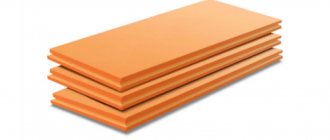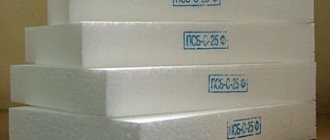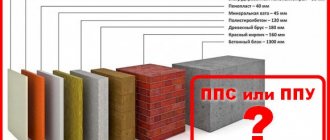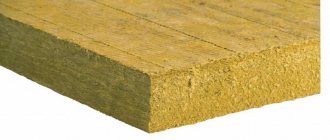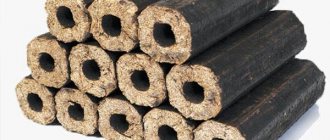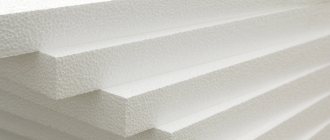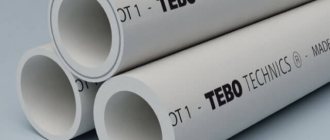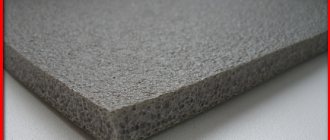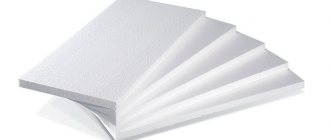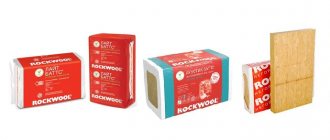In modern construction industry, thermal insulation materials are widely used. Their use allows you to significantly reduce the estimated cost of the facility without losing quality. One of the most popular materials on the insulation market is polyurethane foam.
Polyurethane foam belongs to the group of artificial gas-filled plastics. It consists of polyurethane, between which there are air bubbles. The thermal conductivity of polyurethane foam is almost zero, which makes it an indispensable material at construction sites and in everyday life. There are several types of it:
- Rigid polyurethane foam is a new and promising material that has not yet stood the test of time. To date, scientists have only yet to study the behavior of this material after 30-40 years of operation. It is produced directly on the construction site. It is applied to the surface by spraying. Rigid polyurethane foam is used for insulation and sound insulation of ground and basement floors and foundations.
- Soft polyurethane foam - widely used as padded insulation and for the manufacture of various household items. Its density is 5-35 kg/m/.
Analysis of technical characteristics of polyurethane foam
This article will look at rigid polyurethane foam. It is increasingly being used on construction sites. It has low thermal conductivity and hydrophobicity. PU foam does not allow water vapor to pass through and does not rot. Fungus and mold do not form on its surface. It does not react with most reagents.
For a comprehensive study of this thermal insulation material, its main properties are considered:
- Thermal insulating properties.
- Soundproofing properties.
- Moisture resistance.
- Vapor permeability.
- Behavior in various chemical environments.
- Resistance to open fire.
- Density.
- Lifetime.
- Environmentally friendly.
Summary table of average parameters of the main thermal insulation and finishing materials
Thermal insulation properties
This parameter directly depends on the cell size and ranges from 0.019-0.035 W/mºC. The thermal conductivity of cellular polyurethane foam is worse than that of expanded polystyrene, expanded clay gravel and mineral wool. With the same thickness of the insulation layer, polyurethane foam retains heat much more effectively than the above materials.
Scheme for comparing the thermal insulation properties of various building materials
Soundproofing properties
Its porous and cellular structure provides satisfactory sound insulation, but not from all types of noise.
Important! There is no universal type of noise. Therefore, one material can effectively protect against impact noise, but not at all resist other types.
Polyurethane foam effectively protects interior spaces from various impact noises. This means that it will muffle the sounds of loud footsteps or dancing from neighbors upstairs. On the other hand, according to numerous consumer reviews, polyurethane foam practically does not protect the interior space from sounds from the street, loud conversations or music.
There is a simple explanation for this. Due to their structure, cellular materials (polyurethane foam, polystyrene foam) do not dampen sound waves well. For these purposes, it is better to use insulation with a fibrous structure (mineral wool). Their waves are damped due to vibrations of internal fibers.
Moisture resistance
To properly use thermal insulation materials, you need to know what percentage of moisture it can absorb. For polyurethane foam, this figure is 1-3 percent of the volume of material per day. This figure is significantly higher than that of foam plastic and mineral wool. To improve protection against moisture, additives are added to the PU foam composition. For example, regular castor oil reduces its hydrophobicity by 4 times.
Example of PPU foundation protection below ground level (in a humid environment)
Vapor permeability
In terms of this parameter, cellular polyurethane foam has high performance. Its vapor permeability coefficient is µ=50. For comparison, for heavy concrete this figure is 40-50 times lower. PPU is suitable for treating external surfaces of walls and foundations. It can completely stop concrete from absorbing moisture. On the other hand, it is not recommended for use in water. There is a possibility of a chemical hydration reaction occurring.
Diagram of how a wall “pie” works to remove moisture
Important! Not all polyurethane foam protects well. There are several types of cellular foam without a protective shell. They require additional vapor barrier.
Required thickness of the polyurethane foam layer when spraying
One of the first questions that a business owner in the field of thermal insulation, including in the field of spraying polyurethane foam (PPU), faces is the question of calculating the required thickness of the layer of thermal insulation material. Indeed, there are a lot of variables in the problem - climate zone, heat and humidity conditions indoors, purpose of the room, what part of the building structure is the insulation area, required temperature in the room, heat transfer resistance of the existing building structure, properties of the heat-insulating material, moisture accumulation and some other factors. It is especially difficult when spraying polyurethane foam is used only for a separate part of the building structure, and not for the entire room.
On the one hand, there is a great temptation to please the Customer and offer a smaller layer of thermal insulation material in order to meet his budgetary expectations and be competitive with other options for thermal insulation materials. But on the other hand, failure to achieve the very goal of insulation threatens loss of reputation, financial costs for additional work, or even a lawsuit. In some cases, the opposite situation is observed - the Customer does not believe that a relatively small layer of polyurethane foam can guarantee the desired thermal insulation protection. In our opinion, in both cases, a scientific and evidence-based approach to calculating the required thickness of the heat-insulating layer can become a solid basis.
Let's try, without going into the scientific jungle, to figure out together how to do this.
Behavior in various chemical environments
| Reagents | Concentration, % | Durability |
| Tap water | – | St |
| Sea water | – | St |
| Hydrochloric acid | 36 | Nt |
| Sulfuric acid | 45 | St |
| Phosphoric acid | 40 | St |
| Sodium hydroxide | 40 | St |
| Ammonia water | 25 | St |
| Nitric acid | 68 | St |
| Acetone | – | Nt |
| Ketones | – | Nt |
| Carbon tetrachloride | – | Nt |
| Toluene | – | St |
| Gasoline, petroleum products | – | St |
| Soda | – | St |
| Ethyl acetate | – | Nt |
| Methyl alcohol | 96 | St |
| Ethanol | 96 | St |
| Ethers | – | Nt |
| Acetic acid | – | St |
| Mineral oils | – | St |
| Vegetable oil | – | St |
| Formic acid | – | Nt |
*St – resistant, Nt – unstable
Polyurethane foam has proven itself to be a material resistant to major chemical irritants. It resists evaporation of many chemical elements better than polystyrene foam, if their concentration does not exceed the norm. PU foam cannot be dissolved with gasoline, diesel fuel or various oils. Many concentrated acids are not able to destroy its structure.
Polyurethane foam can be used to protect metal surfaces. During its application to the metal, two layers of film are formed. The first fits tightly to the surface, and the second protects against chemical reagents.
Resistance to open fire
This is an important parameter when choosing insulation. It is no secret that in the event of a fire, the intensity of fire spread largely depends on the flammability of the insulating material. According to GOST 12.1.044-89, polyurethane foam belongs to the flammability groups G2 and G3. According to this classification, polyurethane foam is not an active source of combustion. It does not support the fire itself, but can only be ignited from other sources.
Important! Polyurethane foam will immediately go out if the fire is removed from it. Self-extinguishing is an important property that applies to all its types.
Density
An important parameter affecting the load-bearing capacity of insulation. For various purposes, material with its own density is provided. The range of density values for polyurethane foam is 8-80 kg/m3. Open cell material has a lower density than closed cell material.
Density of various types of polyurethane foam
Heat transfer resistance of polyurethane foam
Before moving on to any thermal calculations, it is necessary to introduce the concept of resistance to heat transfer of enclosing structures, also called thermal resistance. Heat transfer resistance is measured in (m²·K)/W and is designated “R”; in the physical sense, it characterizes the required temperature difference between the outside and inside of a homogeneous material with an area of 1 sq.m for the passage of 1 W of energy. The higher the value of this indicator, the more effective the thermal insulation properties of the enclosing structure.
The calculation formula is simple:
R = d/ʎ,
where d is the thickness of the material layer in meters,
ʎ — thermal conductivity coefficient in W/(m•K).
Let's give an example of calculating the heat transfer resistance of 10 cm of polyurethane foam with a density of 30-40 kg/cubic meter, taking the average thermal conductivity coefficient equal to 0.025 W/(m•K):
R = d / ʎ = 0.1 / 0.025 = 4 (m² K)/W
To understand the meaning of these values, we will give an example of calculating thermal energy losses per 1 sq.m from a roof insulated with 10 cm of polyurethane foam with a density of 30-40 kg/cubic meter. Let's assume that the average annual temperature outside is -5 ˚С, and in the house +20 ˚С. Then the temperature difference will be 25 °C. Thermal energy losses per 1 sq.m from the roof (let’s denote them “E”) will be:
Eср = (Tinternal - Tnar) / R = (Tinternal - Tnar) / (d / ʎ) = (20 - (-5)) / (0.1/0.025) = 25 / 4 = 6.25 W/m2
Thus, we have simplified the calculation of the average annual heat outflow from 1 sq.m of roof per hour. By multiplying the resulting value by the total roof area and the number of hours per year, we will determine the heat loss of the entire roof per year. Of course, we did not take into account such factors as window and attic openings, thermal conductivity resistance of existing structures, cold bridges, etc. But the guideline and calculation scheme are clear.
When performing thermal engineering calculations of enclosing structures in construction, the reference points are the required values of heat transfer resistance of the entire “pie” of the structure (denoted as “Rreq”). Those. The heat transfer resistance of the structure must not be lower than required. These required values can be found in the tables in the above regulatory documents (SNiP, GOST, ST and STO). Moreover, the numbers will differ depending on the climate zone, the humidity conditions of the room and its purpose, as well as what part of the building the calculated structure is (wall, ceiling, roof, foundation, window, etc.).
Lifetime
Most manufacturers indicate a service life of 20-30 years. This is the warranty time during which the useful properties of the material are within acceptable limits. Recent studies by European scientists have shown surprising and encouraging results. When demolishing houses built 40-50 years ago using polyurethane foam, scientists found that its properties remained virtually unchanged. The structure and texture remained the same as originally. Further laboratory studies only confirmed the durability of this material.
Environmental friendliness
An important parameter that modern builders are paying more and more attention to. During the production process, polyurethane foam goes from liquid to solid in 30 seconds. After this, harmful fumes from its surface stop. If it is heated to 450 Cº, carbon dioxide and carbon monoxide will begin to be released. However, the same thing can be observed when wood is heated.
Polyurethane foam does not emit compounds harmful to the human body
Positive and negative properties of polyurethane foam
For a more convenient understanding of the essence, properties and scope of the material, you need to have an idea not only of the physical and chemical properties, but also know its positive and negative sides.
Positive
- Polyurethane foam has good adhesion. It adheres to wood, metal, and concrete surfaces without any problems. It does not require additional fasteners. Due to its elastic structure and method of application, polyurethane foam fits well on uneven substrates. Before applying it, the surface does not require additional treatment with primer or paint.
- PPU has a low cost. It is produced directly on the construction site by mixing two components. There are no costs for additional transportation and manufacturing.
- Polyurethane foam is a lightweight material that does not load building structures.
- In addition to heat and sound insulation, polyurethane foam strengthens load-bearing walls, making the structure stronger and more durable.
- It is practically unaffected by extremely low and high temperatures. PU foam is not destroyed by cyclic freezing and thawing.
- The polyurethane foam coating has a monolithic structure. There are no gaps for the appearance of cold bridges. The wind doesn't blow through it.
Negative
- Polyurethane foam quickly degrades under the influence of ultraviolet rays. Therefore, it does not remain open, but requires protection. It can be covered with a layer of paint or plastered. The use of various cladding panels is also suitable.
- Polyurethane foam is a non-flammable material. Still, it is not recommended to use it in places of possible contact with open fire. If this is technically impossible, then the polyurethane foam is covered with fire-resistant plasterboard.
Polyurethane foam (PPU), pipes in PPU insulation
Polyurethane foam (PPU), pipes in PPU insulation
Reliability is the key word for design and installation work.
This means that all elements of the pipeline design with preliminary insulation made of polyurethane foam (PPU) are simple and durable. We offer polyurethane foam insulation pipes, which are used for channelless installation of pipelines. PPU pipe insulation is one of the ways to save thermal energy when servicing heat supply facilities.
The use of pipelines with thermal insulation made of polyurethane foam in construction and industry is one of the main sources of heat savings today.
Polyurethane foam thermal insulation of pipelines is a fast, seamless application of any complexity and shape, unlimited layer thickness, rapid hardening, as well as resistance to mechanical loads and high energy savings.
Constructions using polyurethane foam have advantageous advantages compared to previously used thermal insulation materials:
- increasing durability from 10-15 years to 30 years or more;
- reduction of heat losses from actual 25-30% to 2-3%;
- reduction in operating costs by 2 times;
- reducing the cost of repairing heating mains by 3 times;
Comparative analysis of the physical properties of rigid polyurethane foam and other thermal insulation materials
| Type of pipe insulation | Thermal conductivity coefficient, W/mK | Density, kg/m³ | Operating temperature range, °C | Porosity | Service life, years |
| PPU hard | 0,019-0,040 | 60-160 | -150…+145 | closed | 30 |
| Expanded polystyrene | 0,043-0,064 | 15-35 | -80…+80 | open | 15 |
| Mineral wool | 0,052-0,058 | 55-150 | -40…+120 | open | 5 |
| Expanded clay | 0,120-0,180 | 200-250 | — | open | 15 |
| Cork board | 0,050-0,060 | 220-240 | -30…+90 | closed | 3 |
Polyurethane foam is a new and most relevant thermal insulation material today, a type of plastic widely used throughout the world. In terms of thermal conductivity, polyurethane foam surpasses almost all known polymers. The closest thing to it is only extruded polystyrene foam, but a polyurethane foam pipe will surpass it in both manufacturability and temperature resistance.
Due to the unusual properties of polyurethane foam, it is used in a wide range of industries. For example, when insulating polyurethane foam pipes and thermal insulation of various pipelines. What is especially important for our country, with its harsh and unstable temperature regime.
Polyurethane foam is highly resistant to chemical compounds (with the exception of some solvents and concentrated acids).
The range of pre-insulated polyurethane foam pipes and connecting units makes it possible to lay a route on any terrain, as well as in cramped urban conditions. The presence of a built-in UEC system allows you to troubleshoot network problems in a timely manner and with minimal losses.
PPU insulated pipes for channelless and above ground installation
Steel pipes with thermal insulation made of polyurethane foam (type 1) in a polyethylene sheath GOST 30732-2001
PPU polyurethane foam shells for thermal insulation of pipes
PPU PE pipes insulated and reinforced with polyethylene sheath
PPU pipes OTs with insulation in a galvanized steel shell ST 4937-001-18929664-04
Insulation PPU (polyurethane foam)
Many modern experts in the field of thermal and waterproofing come to the conclusion that the most optimal material for insulation work, in particular in the construction and industrial sectors, is polyurethane foam (PPU). It is environmentally friendly, has high thermal insulation qualities, and is not prone to destruction after some time. In addition, this material does not have any negative odor and withstands external influences in the form of fungi, acidic substances, and alkalis. Polyurethane foam is often used in the treatment of walls and floors, various types of floors, thermal insulation of pipelines, oil pipelines, hot water supply and heating networks. Polyurethane foam will not be superfluous when working with various refrigeration units.
Thermal insulation using polyurethane foam has a number of positive qualities:
- firstly, installation is characterized by a fairly low labor intensity, because polyurethane foam shells can be attached to the surface either using traditional tape or using polyurethane foam;
- secondly, this material can be reused many times;
- thirdly, PPU insulation does not cause any corrosive effects on the metal;
- fourthly, polyurethane foam is not an obstacle to the damaged section of the pipe;
- fifthly, polyurethane foam has a fairly long service life.
Polyurethane foam shells are made quite simply; for this, in most cases, the method of pouring the components into a special mold is used. The length of such thermal insulation material can vary from one to one and a half meters. On the outside, a protective coating made of fiberglass, aluminum foil, galvanized or stainless steel, sheet aluminum, PVC film can be installed on the polyurethane foam material, and often a special cement-polymer type solution is used for these purposes, which can subsequently be painted.
Polyurethane foam can be applied to the required surface using spraying, and the surface itself can be made of absolutely any material, be it metal, glass, wood, concrete or brick. Moreover, in this matter it does not matter at all what configuration or geometric complexity the surface will be, the main thing is that it is dry and clean. The main advantage of spraying is that the insulation does not require any fasteners. Spraying a polyurethane foam coating resembles the process of painting a particular surface using a spray gun.
Channelless pipeline installation
Recently, construction technologies for channelless or trenchless pipeline laying, which are carried out without opening the soil, have become increasingly in demand. This method is beneficial and convenient, as it does not lead to disruption of existing communications on the site, does not require blocking of transport routes in the area of work, and does not affect the condition of the soil or green spaces. The amenities of the site remain unchanged. In addition, the channelless method of laying pipelines is more than 2 times cheaper than the traditional one, since it does not require preliminary digging of trenches and subsequent restoration of the soil or road surface. Laying a pipeline using the channelless method requires fewer workers, and the absence of mechanisms and trenches at the work site will increase labor safety. Among the modern methods of channelless drilling, the main ones can be distinguished. This is horizontal directional drilling or HDD, piercing the earth, pushing through the pipeline and replacing existing pipes with the simultaneous dismantling of old pipes and laying a new pipeline.
Horizontal directional drilling or HDD is a controlled channelless laying of pipelines up to 1400 m long. This method allows you to lay a pipeline of varying depths under existing communications and obstacles without disturbing or touching them. The HDD method was developed in America in the early 70s of the last century. The first site where this method of laying pipes was tested was a 231 m long pipeline consisting of pipes with a diameter of 115 m, laid under the Pajeiro River in California. For 40 years now, the HDD method has been the main method of laying communications in the United States as the most profitable, convenient and economical.
Technologically, the method of horizontal directional drilling is quite simple. At the entry point of the pipeline there is equipment designed for drilling horizontal wells. The first well (pilot) is drilled along a given trajectory with the exit point at the calculated location. After drilling a pilot well of the required diameter, which can be done in several stages, the pipes are tightened. To better form the channel and ensure normal movement of the pipe along a given trajectory, a drilling fluid - bentonite - is used. The main advantages of HDD are the absence of violations of underground and above-ground communications and structures, as well as the ability to lay pipelines in areas with any type of terrain. HDD makes it possible to lay a pipeline under any above-ground structures, rivers and other bodies of water, build underground foundations or barriers, and rehabilitate existing pipeline communications. The use of HDD can significantly speed up the construction process, saving not only time, but also money. It is also important that HDD installations allow you to lay pipes in polyurethane insulation without causing harm to the environment, damaging the fertile soil layer, or the natural landscape. In general, savings when laying pipelines using the HDD method are up to 30% compared to the traditional trench method. It is rightly believed that trenchless horizontal directional drilling is the future of construction.
To lay polyurethane foam pipes with a diameter of up to 150 mm, a channelless method of piercing the ground is used. A steel pipe is used as a casing for the pipeline, in the front part of which a cone is fixed. Installations operating on the principle of a hydraulic jack provide the pushing force necessary to pierce the ground. The cone pushes the soil apart, compacts it, placing the pipeline in the right place. Tractors, bulldozers, and vibration-impact construction equipment are also used to lay pipelines using this method.
Channelless drilling, designed for laying pipelines with a diameter of up to 2000 mm, uses pipe driving technology. The open end of the pipe, equipped with a special knife device, is pressed into the ground. The developed soil passes into the pipe, from where it is subsequently removed manually or mechanically.
Currently, channelless drilling is also used to replace outdated pipelines with a diameter of up to 800 mm. This method is a convenient solution for rehabilitating pipelines and replacing pipes while simultaneously removing the old pipeline and tightening the new one. When using this method, there is no need to isolate the work site, since more than 90% of it is carried out underground, without affecting the movement of vehicles, pedestrians, etc. The destructive head of the construction equipment moves along the existing pipeline, simultaneously tightening the pipe of the required diameter.
Aboveground pipeline laying
Despite the comparatively lower cost, laying pipelines using the above-ground method is used only in certain cases. It can be:
- desert or mountainous areas,
- places with a high probability of landslides in the presence of geologically unstable soils or obstacles of artificial or natural origin.
In addition, above-ground laying is often used on the territory of industrial facilities and under certain conditions in populated areas.
In any case, this decision must be made after taking into account all factors, including economic and technical feasibility. When constructing these pipelines, as a rule, its load-bearing capacity is used, but in some cases the project must provide for the construction of special bridges.
At the locations of shut-off valves (valves, gate valves, etc.), platforms are built to facilitate their maintenance. As a rule, they are made of lattice-shaped metal structures, which eliminates the possibility of fire and prevents the accumulation of snow and debris.
When the pipeline passes from the underground to the above-ground part (and vice versa), metal mesh fences are installed, the height of which must be at least two meters. In the process of creating a project, it is very important to take into account the longitudinal movement of the pipeline in the place where it goes from underground to aboveground. For this purpose, special underground compensating devices are installed. If the pipeline comes out of weakly cohesive soil, it is necessary to carry out work to strengthen the soil, for example, laying reinforced concrete slabs. Pipeline supports are made of non-combustible materials.
The contact points between polyurethane foam pipes and supports must be isolated from possible electrical contact. The minimum height of the overhead pipeline should be 0.5 meters. For example, when laying a pipeline in sparsely populated areas, the possibility of unhindered migration of animals or their movement must be taken into account. In permafrost conditions, heat from the pipeline should not disturb the soil.
The minimum height of the pipeline when passing through various obstacles should be:
- 0.5 meters from the water level for a ravine or beam;
- 0.2 meters for non-navigable rivers;
- for navigable rivers - by the amount of the established dimensions.
In above-ground pipelines, insulated boxes or ring thermal insulation are used for laying pipes. When transporting under vacuum or pressure (if the diameter is less than 400 millimeters), seamless steel pipes are used. The use of welded pipes is permitted only if they are manufactured in accordance with special technical conditions. If liquefied gas is transported, the joints must be connected by welding. Shut-off valves can be connected via a flange connection. In addition, flange connections are installed in places that require periodic cleaning. The most optimal way to connect joints is welding, which is widely used in above-ground pipelines for various purposes.
For thermal insulation of above-ground pipelines, mineral wool, fiberglass or polyurethane foam are used, protected from precipitation and exposure to sunlight. Polyurethane foam has the best thermal insulation properties. Another important advantage of this material is its high durability. The service life of polyurethane foam coating is from ten to fifteen years.
Thermal insulation in modern heating systems
Thermal insulation is simply necessary in order to reduce heat losses and, accordingly, increase the efficiency of the entire system as a whole. Even minor losses will be quite noticeable. The thermal insulation of pipes itself looks like special shells, coatings made of special thermal insulation materials. These materials are called thermal insulation. During convective heat transfer, layers of materials that are as air-tight as possible are used for thermal insulation. In another case, with radiant heat transfer, materials are used that reflect the spectrum of thermal radiation. Such materials contain many components, among which may be a special foil, which is metallized with a Mylar film. To reduce thermal conductivity, insulation materials with a porous multilayer structure are used. It should be noted that thermal conductivity is the main type of heat transfer, and in this case it is necessary to reduce its level as much as possible. When heat transfer is carried out by conduction, the effectiveness of thermal insulation is determined by its thermal resistance of the insulating structure. A single-layer structure has a thermal resistance, which can be calculated by taking the thickness of the insulating material and its thermal conductivity coefficient. The efficiency of thermal insulation materials can be maximized by using highly porous materials, as well as structures with multi-layer air layers.
But, as always, budget comes first. How to evaluate the effectiveness of thermal insulation? The calculation of economic efficiency is as follows: it is the difference between heat loss without thermal insulation and heat loss with thermal insulation to heat loss without thermal insulation.
The quality of the insulating material underlies not only the minimization of heat losses, but also the durability of the pipeline. Modern technologies change an invention intended for one purpose so much that it becomes multifunctional. For example, with a certain quality characteristic, depending on the materials and manufacturing technology, thermal insulation can additionally serve as anti-corrosion protection for the outer side of the pipeline. Such materials include polyurethane and its derivatives - bion and polymer concrete. What qualities characterize such unique materials? They have low thermal conductivity, regardless of the humidity state of the environment, low water absorption, and also a small height of capillary rise of moisture. These materials are characterized by low corrosive activity and high electrical resistance. Their alkaline reaction environment must have a pH value > 8.5, and the materials themselves must also be mechanically strong and heat-resistant.
Different types of heating pipes have their own thermal insulation standards. For example, insulating materials that are used in underground heat pipelines should focus their production on low water absorption. That is why high-quality thermal insulation materials, which contain a large number of air pores and easily absorb moisture from the environment, are not entirely suitable for pipelines located underground.
The classification of thermal insulation materials is also varied. There are rigid thermal insulation materials, such as slabs, blocks, segments, polyurethane foam shells, bricks. There is a class of flexible materials - cords, bundles, mats, mattresses. Bulk materials are powdery, granular materials, also called fibrous materials. The raw materials from which thermal insulation is made are divided into organic, inorganic and mixed.
Organic materials are divided into natural and artificial. Natural materials include recycled waste from the wood processing industry and non-commercial wood processing, as well as processed agricultural waste, peat and other organic raw materials. Their disadvantage is their low water resistance and biostability. But artificial organic materials do not have these disadvantages. Very promising are foam plastics, which are obtained by foaming synthetic resins. Materials of this group are characterized by closed pores, which do not allow moisture to pass through and are lightweight. A common feature of all organic thermal insulation materials is low fire resistance.
Representatives of inorganic heat-insulating materials alfol - aluminum foil - are used in the form of corrugated sheets folded to form layers of air. Other representatives of this class are glass wool, as well as slag and mineral wool. The average thickness of mineral wool is 7 microns, the thermal conductivity coefficient is 0.045, these materials are characterized by a high water absorption rate of about 600%. There is a huge variety of thermal insulation materials, and they are all designed for a specific environment of use and meet certain operating parameters. Modern developments are moving forward, and heat losses are becoming less and less, justifying economic models for the use and development of thermal insulation materials.
The production group produces and supplies the following pipeline elements in polyurethane foam insulation:
- Pipe in polyurethane foam insulation GOST 30732-2006
- Outlet in polyurethane foam insulation GOST 30732-2006
- Tee in polyurethane foam insulation GOST 30732-2006
- Tee branch in polyurethane foam insulation GOST 30732-2006
- Parallel tee in polyurethane foam insulation GOST 30732-2006
- Tee with vent ball valve in polyurethane foam insulation GOST 30732-2006
- U-shaped element in polyurethane foam insulation GOST 30732-2006
- Z-shaped element in polyurethane foam insulation GOST 30732-2006
- Transition of pipeline to polyurethane foam insulation GOST 30732-2006
- Bellows compensation units in polyurethane foam insulation GOST 30732-2006
- Pipeline element with output cable in polyurethane foam insulation GOST 30732-2006
- Pipeline end element with output cable in polyurethane foam insulation GOST 30732-2006
- Sliding support GOST 30732-2006
- Joint sealing kits (KZS)
7941 views
Application technology
The two components are fed into the mixing tank. There they are mixed under pressure and sprayed onto the surface to be treated using a gun. After a few seconds, the mixture sharply increases in volume and quickly hardens.
Method of applying polyurethane foam
Important! To apply polyurethane foam, special equipment and personal protective equipment are required. Therefore, it is better to entrust this process to professional construction organizations.
Polyurethane foam is a quality material in all respects. Savings of time and money can be 50-70% compared to using traditional insulation. Work can be carried out all year round. Technologies do not stand still, so insulating building structures using polyurethane foam will become cheaper and more reliable.
